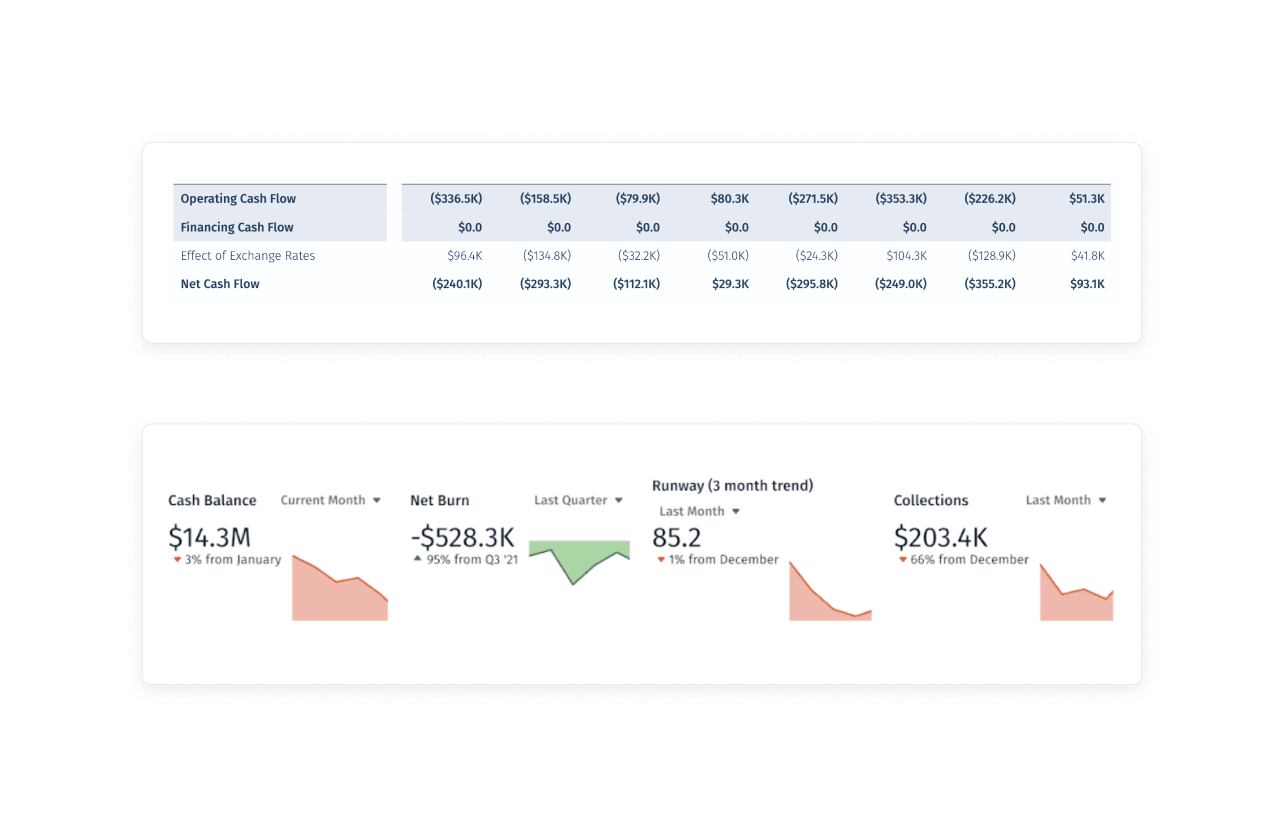Categories
For publicly traded companies, it’s the money left over from operational activities that you can use to pay off debts, pay out dividends, or make acquisitions. As a company matures and moves toward an IPO, free cash flow helps investors and lenders understand the true value of a company and its ability to pay a return on investment.
Companies typically report free cash flow on an annual basis, so you’ll see them in 10-K filings. However, you could also report on free cash flow quarterly in 10-Qs. Internally, if you’re nearing an IPO or already operating a public company, focus on having a real-time understanding of free cash flow and other financial metrics.
Table of Contents
How Is Free Cash Flow Calculated?
Free cash flow is an important financial ratio used to analyze a company. There are multiple ways to calculate your free cash flow, all of which should return the same numbers (or roughly the same).
The simplest method is to take your operating cash flow from your statement of cash flows and subtract any capital expenditures (capex) from it.

You could also use a variety of net income statements and balance sheet line items to get to your free cash flow number. Here are a couple of different methods:
- Subtract your net investment in operating capital from your net operating profit after taxes to find your free cash flow. The formula would be: (Net Operating Profit – Taxes) – Net Investment in Operating Capital = Free Cash Flow
- Subtract your required investments in operating capital from your sales revenue, less your operating costs, including taxes, to find your free cash flow. The formula would be: Sales Revenue – (Operating Costs + Taxes) – Required Investments in Operating Capital = Free Cash Flow
Why Does Free Cash Flow Matter? + How to interpret FCF
There are two sides to a discussion about why free cash flow matters — the internal side and the investor side.
Free cash flow is an important part of overall cash flow analysis because it gives internal finance teams and executives an idea of the position you’re in to re-invest in the business. Do you have the amount of cash needed to develop new products? Can you invest in expanding your presence into new markets? Are you able to buy back stock or pay dividends to keep investors happy? Is there an opportunity to acquire a company to improve your business?
These are all questions you can discuss internally, depending on whether or not you have good visibility into free cash flow.
But on the investor side, free cash flow matters because it gives people an idea of how healthy your business really is. It gives investors a quick look at your company’s profitability and the starting point for a deeper analysis of your business model.
Ultimately, they’ll want to see that you’re putting free cash flow to good use in terms of generating shareholder value. This can make free cash flow and other cash flow metrics a critical part of your investor updates. That doesn’t mean you always have to have positive free cash flow — but it does mean that you have to strategically invest profits to continue growing.
What is Free Cash Flow Margin?
While we’ve discussed what free cash flow is and how it’s calculated, an equally important concept is the free cash flow margin. This metric measures how much of a company’s revenue is converted into free cash flow. It’s an indicator of the efficiency with which a company manages its operating costs and capital expenditures.
Calculating and Interpreting Free Cash Flow Margin
To calculate the free cash flow margin, simply divide the free cash flow by the total revenue and multiply by one hundred. This calculation gives you a ratio that represents the fraction of each dollar of revenue that remains as free cash flow.

A higher free cash flow margin suggests that the company is effectively controlling its costs and is efficient in its operations. It’s a sign of a healthy, well-run business with the potential for growth and profitability.
Free Cash Flow Margin Calculator
Your Free Cash Flow Margin
0%
Why Free Cash Flow Margin Matters
In the context of financial analysis and investor evaluation, free cash flow margin offers a more nuanced view of a company’s financial health than free cash flow alone. It helps in understanding not just how much cash is generated, but how efficiently it’s generated relative to the company’s sales. This efficiency is key in sectors where managing operational and capital costs is crucial for profitability.
What’s Considered “Good” Free Cash Flow?
Free cash flow analysis can tell you many things, but it helps to understand what’s considered good free cash flow within your industry. To have a healthy free cash flow, you want to have enough free cash on hand to be able to pay all of your company’s bills and costs for a month, and the more you surpass that number, the better. Some investors and analysts believe that a good free cash flow for a SaaS company is anywhere from about 20% to 25%.
We often talk about using the SaaS rule of 40 to quickly gauge your balance between growth and profitability. That’s great for companies that are progressing toward an IPO and can work even beyond that point.
But you should also consider evaluating “good” free cash flow in terms of Bessemer’s efficiency score — the sum of your growth percentage and free cash flow margin percentage. Like the rule of 40, anything above 40 in this calculation is considered “good” and bodes well for the valuation of your SaaS company.
Challenges in Tracking Free Cash Flow
The main challenge of tracking free cash flow is adding the necessary context to tell your company’s financial story well.
Free cash flow doesn’t come with the same disclosure requirements that you see in other areas of finance reports, which means it’s not as straightforward as the rest of your financial statement line items. This leaves investors to calculate free cash flow manually if you don’t parse it out on your own.
The result could be a misunderstanding of the company narrative by analysts and investors. For example, you may have a significant drop in free cash flow year-over-year — but it’s actually a positive event because you acquired a company that dramatically expanded your total addressable market.
Manual calculations across the entire financial reporting process can make it difficult to focus on the narrative when you present to investors and board members. By automating the tedious data collection and calculation processes month-to-month and quarter-to-quarter, you’ll be able to spend more time crafting the narrative of the true health of your business.
Get A Better Understanding of the Health of Your Company with Advanced FCF Tracking
With an in-depth awareness of your company’s free cash flow, you’ll have the ability to make effective decisions for the future of your business, as well as understand how investors will view your company’s financial health and bottom line.
Mosaic can help make calculating and tracking important metrics like free cash flow even easier by automating the process. By pulling together data from your existing systems, Mosaic significantly reduces the time your team spends compiling data and calculating metrics while reducing the possibility of human error. Instead, your finance team can focus on what’s happening with your company’s finances in real time and easily model future scenarios with the click of a button that can help your company focus on growth.
Instead of relying on spreadsheets and manual calculations to track the health and growth of your business, consider Mosaic. Get a personalized demo to see how Mosaic can provide a comprehensive overview of the health of your business.
Free Cash Flow FAQs
Why is free cash flow important for valuation?
Free cash flow plays an essential role in valuation as it shows how much capital a company has available to invest in growth, pay off its debts, or return dividends to investors, which is an indicator of financial health that investors use to determine its present value.
What are the differences between Free Cash Flow and EBITDA?
How does working capital affect Free Cash Flow?
Explore Related Metrics
Own the of your business.






